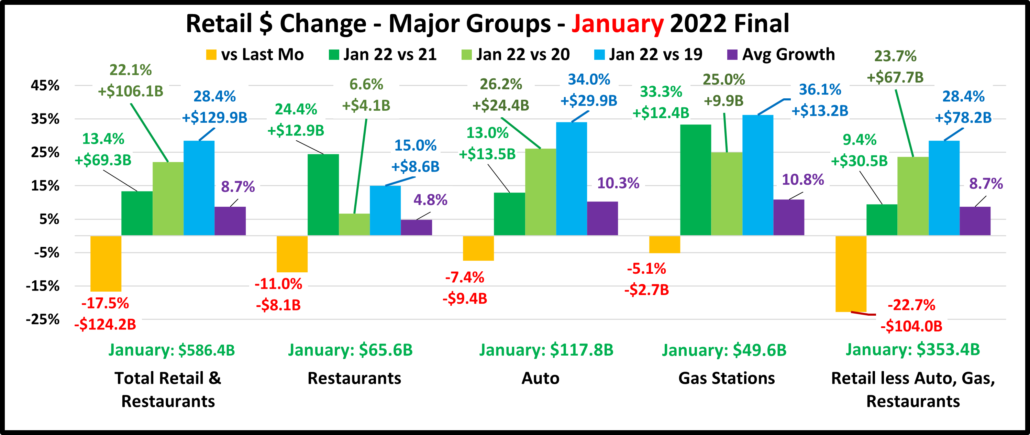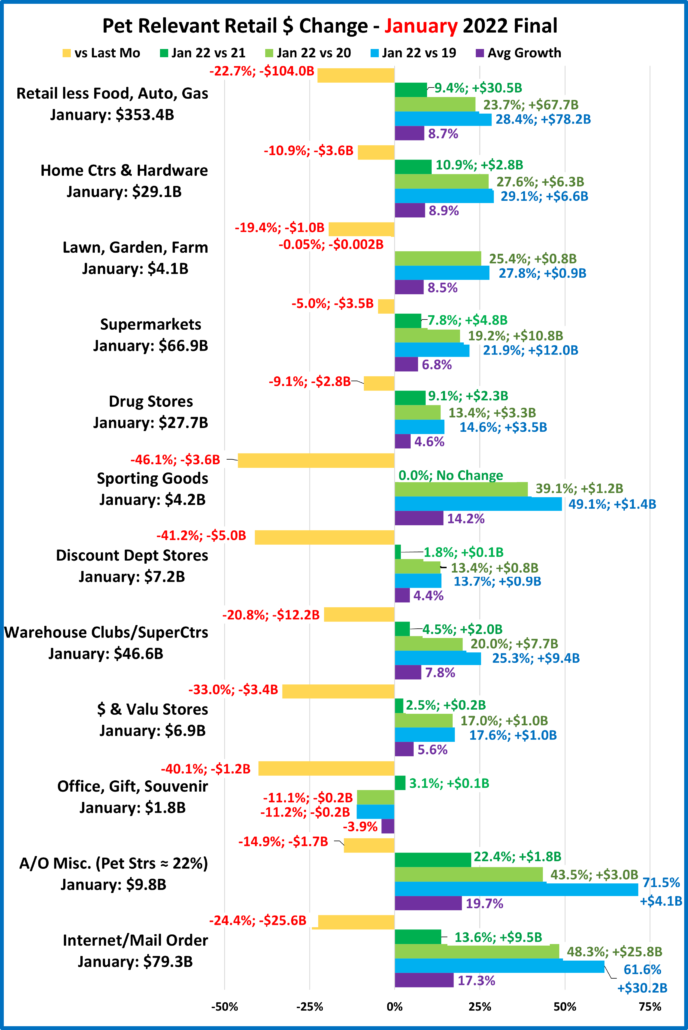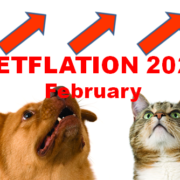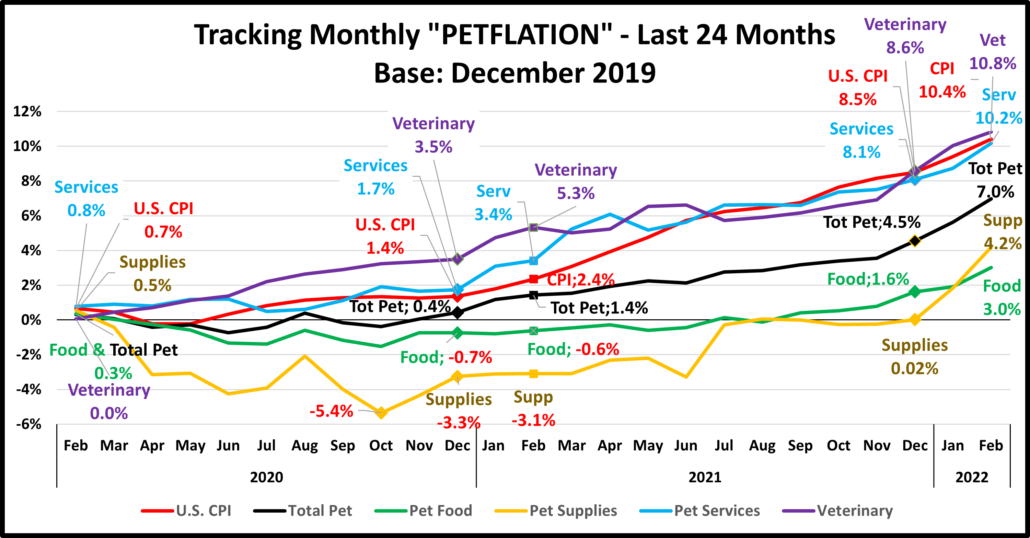Retail Channel Monthly $ Update – January Final & February Advance
The Retail recovery has been generally successful, but now, our attention has turned to an unexpected factor also attributed to the pandemic – extreme inflation. Since this can affect retail sales, we will continue to track the retail market with data from two reports provided by the Census Bureau and factor in the CPI from US BLS.
The Census Bureau Reports are the Monthly and the Advance Retail Sales Reports. Both are derived from sales data gathered from retailers across the U.S. and are published monthly at the same time. The Advance Report has a smaller sample size so it can be published quickly – about 2 weeks after month end. The Monthly Final Report includes data from all respondents, so it takes longer to compile the data – about 6 weeks. Although the sample size for the Advance report is smaller, the results over the years have proven it to be statistically accurate with the final monthly reports. The biggest difference is that the full sample in the Final report allows us to “drill” a little deeper into the retail channels.
We begin with the Final Retail Report for January and then move to the Advance Report for February. We will now compare 2022 to 2021, 2020 and 2019. In both reports we will show both the actual and the “real” change in $ as we factor inflation into the data.
Both reports include the following:
- Total Retail, Restaurants, Auto, Gas Stations and Relevant Retail (removing Restaurants, Auto and Gas)
- Individual Channel Data – This will be more detailed in the “Final” reports, and we fill focus on Pet Relevant Channels
The information will be presented in detailed charts to facilitate visual comparison between groups/channels of:
- Current Month change – % & $ vs previous month
- Current Month change – % & $ vs same month in 2021, 2020 and 2019.
- Current YTD change – % & $ vs 2021, 2020 and 2019 (In the Jan. Final, YTD is unnecessary, so we add the Avg chge)
- Monthly and Year To Date $ will also be shown for each group/channel
First, the January Final. Retail hit bottom in April 2020 but began recovery. The recovery strengthened in 2021 and became widespread. Total Retail $ broke the $700B barrier for the 1st time in December. As usual, $ dropped from December but 2022 started strong. Here are the major retail groups. (All $ are Actual, Not Seasonally Adjusted)
The January Final is $5.5B more than the Advance Report. Only 1 group was down. Specifically: Restaurants: -$0.3B; Auto: +$1.7B; Gas Stations: +$0.2B; Relevant Retail: +$3.9B. The normal big drop in retail sales from December is readily apparent but it is less than in past years. The recovery for Restaurants and Gas Stations is late and still surging. All groups have now been positive vs past years for 8 consecutive months. Now, let’s look at the “Real” January lift, factoring in inflation. The Jan 22 to Jan 21 inflation was 7.5% overall. That would put the “real” increase for Total Retail at +5.9% (44% of 13.4%); Restaurants – Inflation = 6.4%. Real Increase: 18.0% (73.8%); Auto – New & Used Vehicle Inflation = 23.1%. It’s likely that sales were down as much as -10%; Gas Stations – Gasoline Inflation = 40.0%. Real Change: -6.7%. Relevant Retail – Inflation = 7.5%. Real Increase: 1.9% (20.2%). Inflation is a major problem.
Now, let’s see how some Key Pet Relevant channels did in January.
Overall – You see the importance of the holiday buying surge to these channels as all were down vs December and only the most essential channels – Supermarkets and Drug Stores had less than double digit decreases.
- Building Material Stores – Their amazing lift has slowed in the winter months, especially in Farm Stores, which had the only decrease vs January 2021. Most of the increase from 2019 for both Home Ctr/Hdwe and Farm Stores came from the 20>21 lift. Home Ctr/Hdwe $ continued to grow but Farm Stores just held their ground. The January YOY inflation for Tools, Hdwe, Outdoor Equip/Supp was 10.7% That makes the January “real” numbers:
Home Ctr/Hdwe: +10.9%, Real: +0.2%; Farm Stores: -0.05%, Real: -10.8%
- Food & Drug – Both of these channels are truly essential. Except for the food binge buying in the early part of the pandemic, they tend to have smaller fluctuations in $. Supermarkets have had stronger growth since 2019. Much of that is due to more families choosing to cook at home. Here are the real January numbers which may be a surprise. The inflation rate for Food at Home in January was 7.4%. Prices for Drugs (Rx & OTC) were up only 1.3%. The YOY growth was
Supermarkets: +7.8%, Real: +0.4%; Drug Stores: +9.1%, Real: +7.8%
- Sporting Goods Stores – Like Hardware/Farm stores, they benefited from the pandemic in that consumers turned to self-entertainment, especially sports & outdoor activities. They had a huge drop from December but managed to stay at the extraordinarily high 2021 level. The high demand has pushed the inflation rate for Sporting Goods to 8.2%. There was literally no $ growth from January 2021 to 2022. Considering inflation, that equates to an -8.2% drop in sales.
- General Merchandise Stores – $ in all channels fell substantially from December but were up slightly from January 2021. SuperCtrs/Clubs have a higher percentage of groceries which makes for more frequent visits and generally higher numbers, including growth rate. Discount Dept Stores were struggling before COVID but had a strong 2021. Using the overall inflation rate of 7.5%, here are the January numbers
SupCtr/Club: +4.5%, Real: -3.0%; $/Value Strs: +2.5%, Real: -5.0%; Disc. Dept. Strs: +1.8%, Real: -5.7%
- Office, Gift & Souvenir Stores – These non-essential stores started to recover in the spring of 2021, but they are still not there yet. Sales are up vs January 2021, but every other measurement is negative, including vs 2019. The available inflation number most appropriate for them is “limited” as it cuts out food, energy, shelter and used vehicles – +5.1%. Their sales were +3.1% so real sales were actually down -2.0%.
- Internet/Mail Order – The sales growth of the undisputed “hero” of the Pandemic is slowing as they were up 13.6% from 2021, slightly slower than their average growth rate of 17.3%. With inflation at 7.5%, their real growth is 6.1%.
- A/O Miscellaneous – This is a group of specialty retailers. Pet Stores are 22>24% of total $. In May 2020 they began their recovery which reached a record level by December 2021 as annual sales reached $100B for the first time. January $ are up 22.4% from 2021. Using the 5.1% “limited” inflation rate, their real sales are +17.3%. However, by any measure, they are the percentage leader in January growth. Take note: In January 2022, this group, of which Pet Stores are an important and growing segment, beat the growth rate of Internet/Mail Order over both last year and since 2019.
Inflation is an important factor. In actual $, 9 of 11 channels increased sales over January 2021. However, when you factor in inflation, including the rate most in tune with each Channel’s offerings, the number with any “real” growth falls to 5. Until things change, inflation will be a big part of retail sales discussions. Now, the Advance numbers for February.
We have had 2 straight memorable years. 2020 saw the 2 biggest monthly drops in history but Total Retail finished by reaching $600B for the first time in December. In 2021, the recovery strengthened with all big groups positive in all measurements vs 2019 & 2020 for the final 7 months. Total Retail reached $713B in December and broke the $7T barrier for the year. Relevant Retail was also strong as annual sales reached $4T but in fact, all big groups set annual sales records in 2021. As usual, sales fell in January from their December peak and driven down by Relevant Retail, Total Retail $ continued to decline in February. In virtually every year, February is the low point for retail sales.
Overall – The only negative numbers are vs January and not for all groups. We should also note that the February sales patterns since 2019 look normal for Total Retail, Relevant Retail and Auto with annual increases. Remember, February 2020 was pre-pandemic and by February 2021, only Restaurants and Gas Stations had not begun a strong recovery.
Total Retail – January Sales set a record beating the 2021 record by 13.4%. February was even better, breaking the $500M barrier for the 1st time and beating the 2021 record by 17.7%. YTD numbers are up 15.5%, with an annual growth rate since 2019 of 9.0%. However, 59% of the growth since 2019 occurred from 2021 to 2022 which brings inflation into the conversation. The inflation rate for February 2022 vs 2021 was 7.9%, even higher than January. YTD prices are up 7.7%. Here are the numbers. February: +17.7%, Real: +9.8% (55.4%); YTD: +15.5%, Real: +7.8% (50.3%). Inflation is a big factor, but real growth is still strong.
Restaurants – They were hit hard by the pandemic and didn’t truly start to recover until March 2021. However, sales in 7 of the last 8 months of 2021 exceeded $70B and 2021 was the biggest year in history, $821B. January sales fell from December but turned up in February. This happens about half of the time as these 2 months compete for the low point in Restaurant sales. Their February sales pattern clearly reflects their late recovery, especially from a $12B drop in 2021. YTD sales are up an average of 5.1% since 2019, becoming more normal. Inflation for Food away from home in February was 6.8%. YTD, it is 6.6%. Here is real growth. February: +33.0%, Real: +26.2% (79.4%); YTD: +28.6%, Real: +22.0% (76.9%) This is by far the best performance of any group and significantly improves the Total Retail numbers.
Auto (Motor Vehicle & Parts Dealers) – This group actively worked to overcome the stay-at-home attitude with great deals and a lot of advertising. They finished 2020 up 1% vs 2019 and hit a record $1.54T in 2021. In January, sales fell but then turned up in February, the usual pattern in a normal year. Their YTD growth rate since 2019 is 10.4%, the highest of any big group. But what about inflation? The overall inflation rates of Feb: 7.9% and YTD: 7.7% would produce real increases of Feb: +9.7%; YTD: +7.7%. However, the inflation rates for new & used vehicles, which account for most of the sales in this group, were Feb: +23.5%, YTD: +23.3%. This would create a real drop in sales of Feb: -5.9%, YTD: -8.0%. It seems likely that there is an ongoing drop in the actual amount sold in this group which is tied to extreme inflation.
Gas Stations – Gas Stations were also hit hard. If you stay home, you drive less and obviously need less gas. This group started recovery in March 2021 and reached a record $588B for the year. January sales fell -5.1% from December and February sales also dropped slightly. However, they were up 36.6% vs 2021. Gasoline inflation is in all the headlines so let’s get right to the numbers. Gasoline inflation vs 2021 for February is 38% and YTD is 39% which generates the following. February: +36.6%, Real: -1.4%; YTD: +34.9%, Real: -4.1%. While the gap is narrowing, extraordinarily high prices are hindering growth. People are ready to get out and about, but high gas prices are causing them to reconsider.
Relevant Retail – Less Auto, Gas and Restaurants – This the “core” of U.S. retail and accounts for 60+% of Total Retail Spending. There are a variety of channels in this group so they took a number of different paths through the pandemic. However, their only down month was April 2020. They finished 2020, up +7.1% and 2021 got even better as they reached a record $4.47T. They have led the way in Total Retail’s recovery which became widespread across the channels. In January and February sales fell from the previous month but this is the normal pattern. Sales hit bottom in February then begin a Spring lift. Both January & February set new monthly $ records and the YTD annual growth rate is 9.0% with a relatively normal growth pattern. Although over 40% of the increase since 2019 occurred this year. That says we should look at the impact of inflation. We’ll use the overall inflation rates: February: 7.9%, YTD: 7.7%. February: +12.8%, Real: +4.9% (38.3%); YTD: +11.1%, Real: +3.1% (27.9%). Although this is significantly better than January when real growth was only 0.7%, it is still concerning when only 1/3 of the growth in this big group is real.
Gas Stations are unquestionably the inflation loser but now Relative Retail and Auto, which had the strongest recovery from COVID are starting to feel the effect of strong inflation. Next, we’ll drill down to look at what is happening in the individual retail channels. Remember, the channels in the chart are less defined than in the Final Monthly reports and we will look across the whole market, not just pet relevant outlets.
- Relevant Retail: Feb: +12.8%, Real: +4.9%; YTD: +11.1%, Real: +3.4%. 9 of 11 channels were down vs January but all were up vs February 2021. In fact, 10 of 11 were up in all measurements vs 2019>2021. It was a record month.
- All Dept Stores – This group was struggling before COVID, and the pandemic hit them hard. They began to recover in March 2020, and they have continued to grow through February. The most appropriate inflation rate to use for them is less Food, Energy, Shelter & used vehicles which are Feb: 5.3%, YTD: 5.1%. That puts their numbers at Feb: +22.4%, Real: +17.1%; YTD: +16.3%, Real: +11.2%. Their recovery is getting stronger by any measure.
- Club/SuprCtr/$ – They fueled a big part of the overall recovery because they focus on value which has broad consumer appeal. Inflation is a big factor in their current numbers as their lift has slowed at least temporarily. Using the national CPI, Feb: +10.9%, Real = +3.0%, YTD: +7.4%, Real: -0.3%
- Grocery – These stores are the most essential and depend on frequent purchases so except for the binge buying in 2020, their changes are generally less pronounced. However, inflation has also hit Groceries, 8.6% in February and 8.0% YTD. This is the biggest increase since 1981. February: +8.4%, Real = -0.2%; YTD: 8.0%, Real: 0.0% – No Change
- Health/Drug Stores – At least the drug stores in this group are essential, but consumers visit far less frequently than Grocery stores. Their February sales actually dropped in 20>21 but most of their COVID ride has been rather calm. Using the CPI for Rx & OTC drugs (Feb: 2.5%, YTD: 1.9%) their numbers are: Feb: +8.7%, Real: +6.2%; YTD: +8.8%, Real: +6.9%
- Clothing and Accessories – They were also nonessential and what you were wearing didn’t matter when you stayed home. That changed in March 2021 and consumers’ pent-up needs caused explosive growth which has continued through February. Apparel inflation is Feb: 6.6%, YTD: 6.0%. Their $ are Feb: +31.0%, Real: +24.4%; YTD: +25.8%, Real: +19.8%
- Home Furnishings – They were also less impacted by COVID. Sales dipped Mar>May in 2020. Then as consumers’ focus turned to their homes, furniture became a priority. Inflation on Furniture is extremely high, 17.1% for both February and YTD. That causes a big turnaround in their numbers. Feb: +7.4%, Real: -9.7%; YTD: +4.4%, Real: -12.7%
- Electronic & Appliances – Look at the graph. This channel has problems beyond the pandemic. Sales fell in Apr>May of 2020 and didn’t reach 2019 levels until March 2021. Right now, their sales are stagnated. We’ll wait and see if they have a yearend lift. We’ll use the “limited” CPI: Feb: 5.3%, YTD: 5.1%. Feb: +2.6%, Real: -2.7%; YTD: -0.4%, Real: -5.5%.
- Building Material, Farm & Garden & Hardware –They truly benefitted from the consumers’ focus on home. Their spring lift has become almost year-round and it’s ready to start again. The CPI for Hdwe & Outdoor is Feb: 10.6% YTD: 10.7%. Here are their February numbers. Feb: +14.9%, Real: +4.3%; YTD: +12.0%, Real: +1.3%.
- Sporting Goods, Hobby and Book Stores – Consumers turned their attention to personal recreation and sales in Sporting Goods outlets took off. Book and Hobby Stores recovery was slower. It appears that the YTD lift has slowed in 2022. The product groups in these outlets have radically different CPIs so using the “limited” inflation version seems to be the best choice. Feb: 11.6%, Real: 5.3%; YTD: 5.7%, Real: 0.6%.
- All Miscellaneous Stores – Pet Stores have been a key part of the strong and still growing recovery of this group. They finished 2020 +0.9% but sales took off in March 21, setting a new monthly record in December. The growth continues in 2022 as they are 2nd to Clothing in February & YTD lift. Since 2019 their growth is 2nd to NonStore. The “limited” CPI also seems right for this group and generates these great numbers. Feb: +24.6%, Real: +19.3%; YTD: +21.2%, Real: +16.1%
- NonStore Retailers – 90% of the volume of this group comes from Internet/Mail Order/TV. The pandemic accelerated the movement to online retail. They ended 2020 +21.4%. The growth continued in 2021 and in December monthly sales exceeded $100B for the 1st time and they broke the $1 Trillion barrier in annual sales. Growth is a little slower in 2022 but still strong. Using the national CPI, their latest numbers are Feb: +13.9%, Real: +6.0%; YTD: +14.3%, Real: +6.7%
Note: Almost without exception, online sales by brick ‘n mortar retailers are recorded with their regular store sales.
Recap – 2020 was quite a year, with the trauma of April & May followed by the triumph of breaking $600B for the first time in December. 2021 was even more memorable as it produced record sales for all major groups and Total Retail exceeded $7T for the 1st time. Relevant Retail was the major driver in this recovery. Since May of 2020 their sales have exceeded past years in all measurements, and they reached $4.47T in 2021. The recovery was widespread as all but 2 groups on our Advance Chart set sales records in 2021. 2022 began pretty normally for Relevant Retail as sales fell from December but exceeded 2021. The big change was that inflation that began in late 2021 hit levels not seen in decades and came to the forefront of every conversation. As we saw in our analysis, it affected virtually every channel and even turned 4 channels from positive to negative. This will not go away quickly and if it continues or worsens it will ultimately result in consumers buying less, ending retail growth by any measurement. We will continue to monitor the situation.













